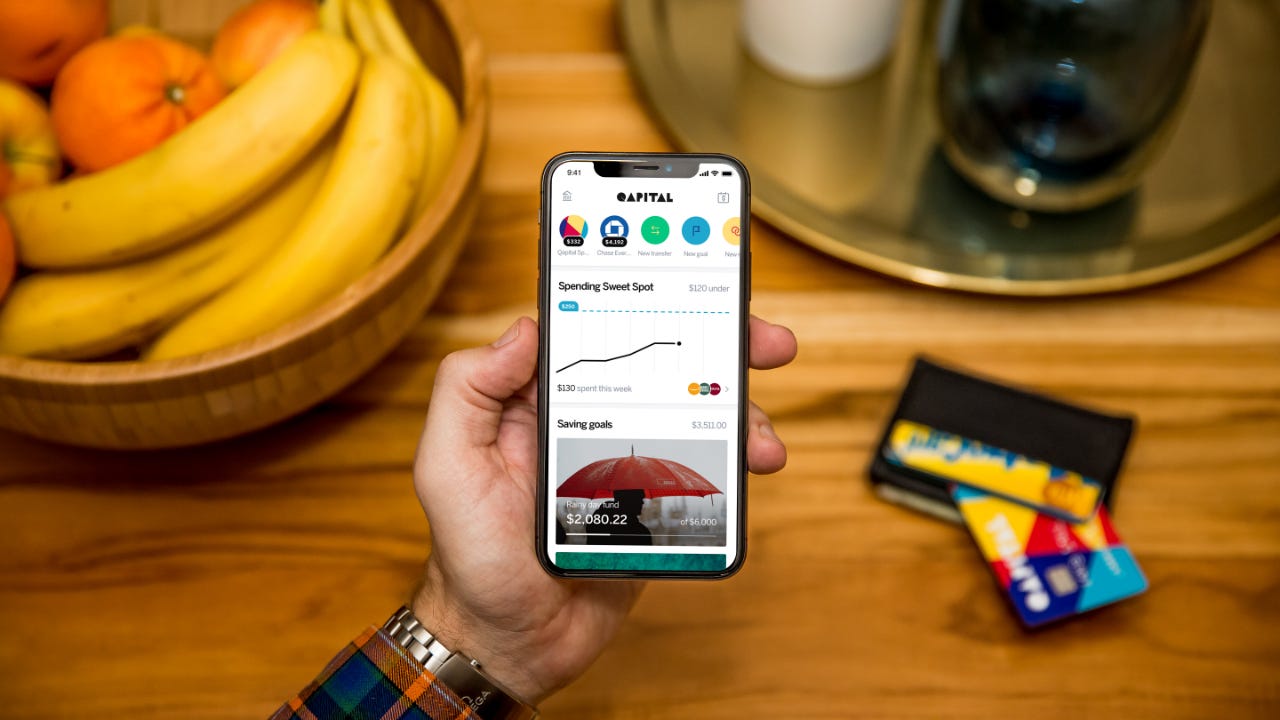9 best money-saving apps of 2024

Saving money can be challenging, but technology is making it easier than ever. Whether you’re a seasoned saver or just getting started, money-saving apps can help you build up your bank account. These apps are designed to help you save automatically, track your spending and develop healthy financial habits — all while eliminating the stress of micromanaging your budget.
Each app offers unique tools and strategies to assist you in your savings journey. All you’ll need is a checking account, a smartphone and a commitment to your financial goals.
Read more about the best money-saving apps of 2024, their costs and features and how they work. With the right app, saving money becomes effortless.
1. Oportun
Oportun is an automated savings app that tracks your checking account’s activity and periodically moves funds into savings. Its algorithms analyze your spending patterns and determine safe amounts to transfer — ensuring that you’re never left short on cash.
This app is perfect for those who identify more as spenders than savers, as it takes the decision-making process out of your hands. Oportun helps you save money without overthinking it.
After a free 30-day trial, Oportun costs $5 per month. With this fee, you gain access to its auto-savings feature and the ability to set savings goals directly within the app. One of its key features is that it won’t withdraw money if it determines you’re not in a financial position to save, avoiding any chance of overdrawing your account.
Oportun, which was known as Digit before 2023, is not a bank itself, but it partners with FDIC-insured institutions, meaning your funds are insured up to $250,000 per depositor.
Best for: Outsourcing savings decisions
Cost: Free for 30 days, then $5 per month
2. Qapital
Qapital turns saving into a fun and automated process using “savings rules.” Users can set up rules such as transferring a small amount into savings every time they indulge in a guilty pleasure like takeout. Additionally, Qapital can round up debit card purchases and stash the spare change into your savings.
The app excels at helping users visualize their savings goals by allowing them to attach photos and create a digital vision board to keep themselves motivated. It’s a great app for those who like a visual and goal-based approach to saving.
Qapital also offers multiple financial products. You can link your existing checking account or open a Qapital Spending account, which comes with a debit card. There’s also the option to open a savings account, share goals with a partner or even invest through the Qapital Invest account.
Best for: Visualizing savings goals
Cost: Starts at $3 per month with tiered plans and a 30-day free trial
3. Goodbudget
Goodbudget is ideal for anyone who prefers a manual budgeting system. This app operates based on the traditional envelope budgeting method, where you allocate portions of your income into virtual “envelopes” for categories like housing, groceries and savings.
Unlike automated apps, Goodbudget requires you to input your expenses manually, which allows for greater control over where your money goes. It’s a fantastic option for those who enjoy hands-on financial management and don’t mind a little extra work.
Goodbudget is also family friendly. It can sync across multiple devices, allowing all household members to track and manage the family budget together. The free version includes up to 10 envelopes, but for $10 a month, you can unlock unlimited envelopes and sync across five devices.
Best for: Manual budgeting with family-sharing options
Cost: Free for limited features, $10 per month for premium
4. Chime
Chime is a popular digital-only financial brand that has garnered millions of users with its auto-savings tools and competitive interest rates. When you open a Chime account, you can enable features such as automatic savings transfers, which move a percentage of your paycheck directly into savings each time you get paid. You also have the option to get paid early if you have set up direct deposit.
Another handy feature is Chime’s round-up option, where each debit card purchase is rounded up to the nearest dollar, with the extra change moved into your savings account. This can significantly boost your savings over time without you even noticing.
While Chime is not technically a bank, it partners with FDIC-insured institutions like The Bancorp Bank and Stride Bank, ensuring your funds are protected.
Best for: Saving spare change with a banking app
Cost: Free
5. Current
Current is a fintech company offering both checking and savings account features. Its mobile app provides account holders with a debit card, savings goals (called “pods”) and the ability to earn interest on deposits. You can create multiple savings pods, which automatically sweep money in to help you save for specific goals, like a vacation or emergency fund.
Funds deposited into your savings pods earn interest, although this only applies to $2,000 per pod. Additionally, Current allows users to trade cryptocurrencies without transaction fees, a feature that sets it apart from many traditional banking apps.
Like Chime, Current is not a bank itself but works with FDIC-insured partners Choice Financial Group and Cross River Bank.
Best for: Users seeking a flexible alternative to traditional banking
Cost: Free for basic services
6. Acorns
If you already have an emergency fund and want to try investing, Acorns could be the app for you. Acorns helps you save and invest your spare change by rounding up each transaction to the nearest dollar. The extra cents go directly into an investment portfolio tailored to your financial goals.
Acorns offers a beginner-friendly platform for those new to investing, making it an excellent option for novice investors. In 2023, Acorns introduced the Mighty Oak Debit Card, which allows you to invest spare change from purchases made with the card.
The Mighty Oak card also includes a high-yield deposit account with a 3 percent APY on checking balances and a 4.52 percent APY on savings. Your funds are protected by FDIC insurance through Acorns’ partner banks, Lincoln Savings Bank and NBKC Bank.
Best for: Novice investors looking to grow their savings
Cost: Starts at $3 per month
7. Rocket Money
Rocket Money offers a comprehensive suite of budgeting and savings tools. It links to your bank, credit cards and investment accounts, giving you a clear picture of your financial health. Rocket Money also identifies recurring subscriptions and helps you cancel services you no longer use.
The app provides personalized financial insights, tracks your spending and even sends alerts when your balance is running low. The paid version includes features such as subscription cancellation assistance and bill negotiation services for those who want extra support.
Rocket Money is ideal for users who want to take control of their budget while eliminating unnecessary expenses.
Best for: Budget-conscious savers looking for subscription management
Cost: Free version available, premium costs between $6 and $12 per month
8. You Need a Budget (YNAB)
You Need a Budget, or YNAB, is designed for users who want complete control over their finances. The app’s philosophy is that every dollar should have a job — whether that’s for saving, investing or spending. YNAB encourages users to budget only the money they already have, preventing overspending.
You can link your bank accounts and credit cards for automatic tracking or choose to input your information manually. The app also provides education on how to manage debt and build wealth, making it more than just a budgeting tool.
According to YNAB, new users save an average of $600 in their first two months and $6,000 in their first year. It’s a great option for those who prefer a structured, hands-on approach to budgeting.
Best for: Hands-on budgeters looking to take control of their finances
Cost: Free for 34 days, then $14.99 per month or $109 per year
9. Upside
Upside, previously known as GetUpside, is a cash-back app that rewards you when you shop for essentials like gas and groceries.
Upside has local, limited-time deals that users can claim. There are lots of gas stations and restaurants that offer deals, making expensive gas prices easier to stomach.
When you sign into the app, you can claim a cash-back offer at a nearby location. Then, you shop as you normally would. When the offer is processed, you can cash out your earnings to your bank account, PayPal account or a gift card.
Use a credit card that gives you cash-back rewards for the purchases you make through the Upside deals.
Best for: People who want to get cash-back opportunities with their regular shopping.
Cost: Free
Are money-saving apps safe?
Security is a top concern when you’re sharing your banking data with an app. The best money-saving apps implement multiple layers of protection, including encryption and secure connections, to keep your personal information and money safe.
To ensure your savings are protected, always check whether the app partners with an FDIC-insured and chartered bank. If so, your money is insured for up to $250,000 per depositor in case anything goes wrong.
Why you should use a money-saving app
If you tend to spend before you save, apps that help you save money can change your habits by automating the process. Instead of thinking about saving large sums at once, you can use these apps to regularly move smaller amounts into savings, making it easier to reach your financial goals.
After building up your savings, consider transferring your funds into a high-yield savings account or a certificate of deposit (CD) to take advantage of better interest rates.
The bottom line
The best money-saving apps of 2024 offer solutions for every type of saver, from hands-on budgeters to those who prefer automated transfers. These apps make it easier to track spending, save without stress and even invest in your future.
When choosing the right app, consider factors like the level of automation you need, the cost of the app and whether you prefer to link a bank account or use manual tracking. With many apps offering free trials or basic services, it’s easy to test out a few and see which works best for you.
Whether you’re just starting your savings journey or looking to grow your existing funds, using apps that help you save money will put you on the path toward financial success.
You may also like

Top money-saving and management apps with sign-on bonuses





